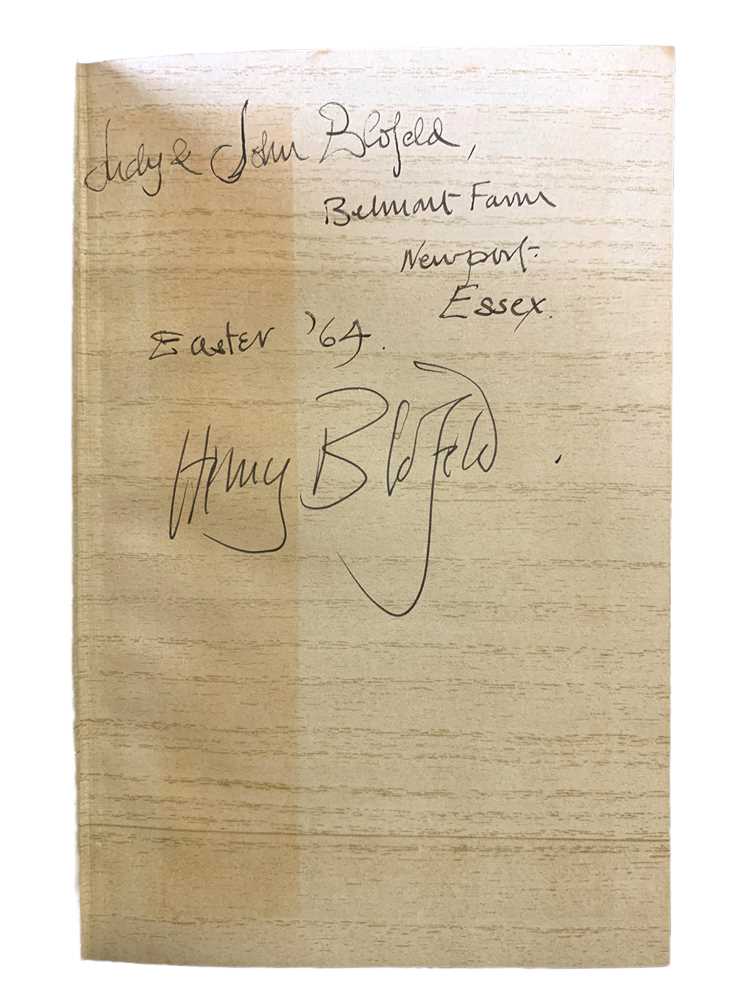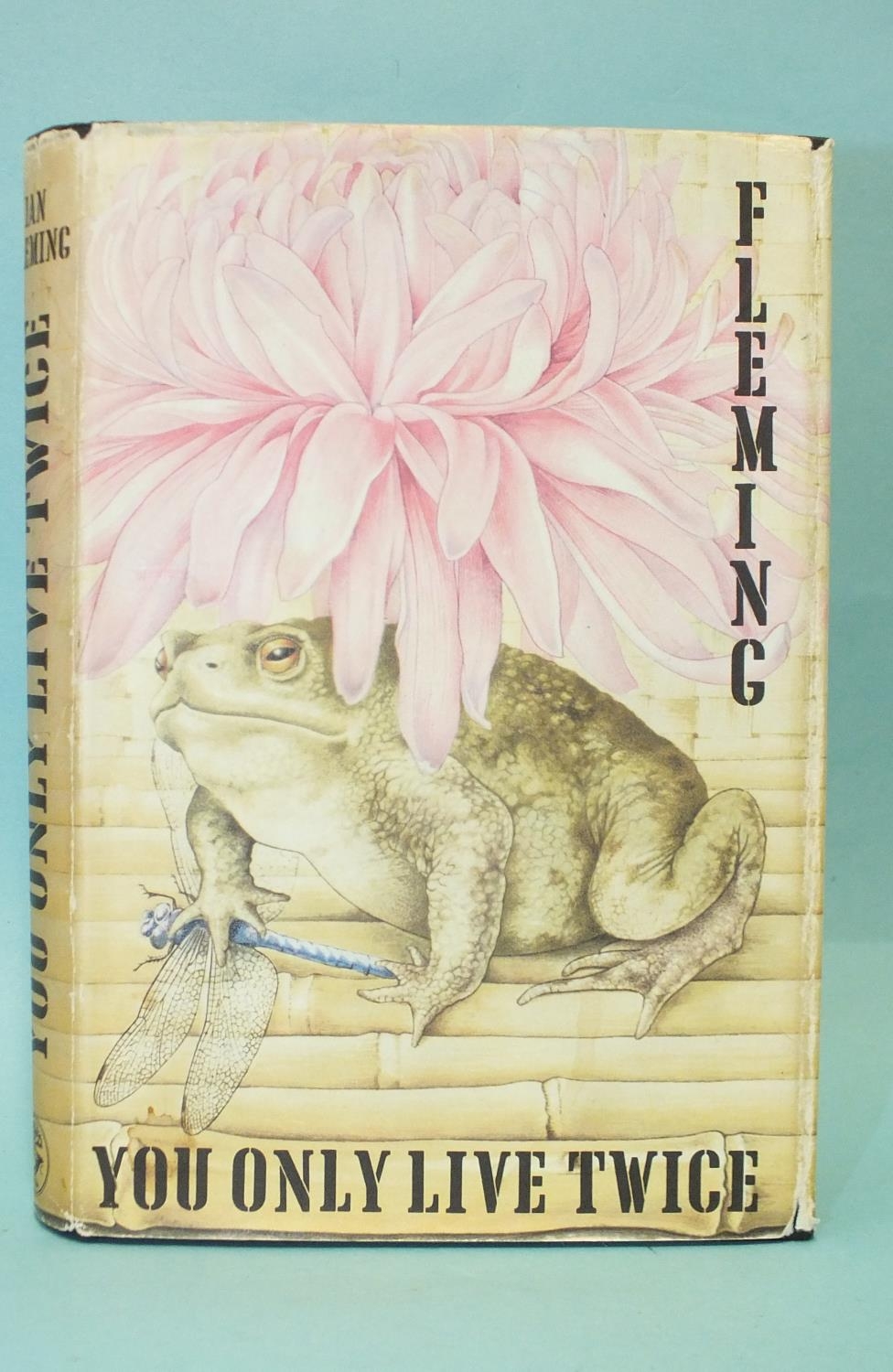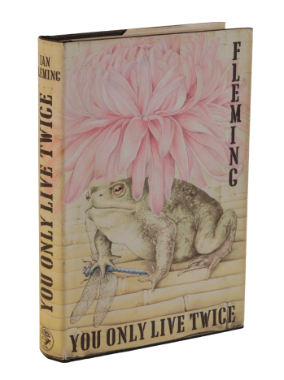FLEMING, Ian. You Only Live Twice. London: Jonathan Cape, 1963. 8 o. Original cloth like black boards, lettered in silver (spine a bit cocked, light offsetting to endpapers); pictorial dust jacket after a design by Richard Chopping (minor rubbing to edges). Provenance : Richard Hughes (b.1906, presentation inscription). ONE OF THE DEDICATION COPIES OF THE FIRST EDITION, INSCRIBED BY FLEMING TO RICHARD HUGHES on the front free endpaper: "To Dikko-san from Fleming-san. With all affection." The printed dedication is "To Richard Hughes and Torao Saito (see lot 202, Fleming's notebook). But for whom etc..." Hughes and Tarao "Tiger" Saito travelled around Japan with Fleming. Richard Hughes ("Dikko Henderson" in the novel) first went to Japan in 1940, when he was the only Australian journalist, and he returned in 1945. In 1948 he and some friends decided that there ought to be a branch of the Baker Street Irregulars in Japan, so they started one, calling it The Baritsu Chapter. Richard Hughes was the Chief Banto of the society, and its members included Prime Minister Shigeru Yoshida, the elder statesman Count Makino, Kenichi Yoshida, and Torao Saito. The Prime Minister was unable to attend the society's first meeting because he had a conflicting appointment: a meeting with General Douglas MacArthur, but he made sure that he could attend the second meeting. Hughes was also the model for Bill Craw in John le Carre's The Honourable Schoolboy . In 1959, Fleming made a five-week round-the-world tour for Thrilling Cities , a travelogue he wrote for the Sunday Times (later printed in book form by Jonathan Cape). During his travels, Pearson reports, Fleming "struck up an immediate friendship with Richard Hughes the mountainous Australian ex-heavyweight who had represented the Sunday Times in the Far East since the Korean war. Tough, sentimental, immensely knowledgeable, Hughes was exactly the man Fleming needed for the success of this brief introduction to the Far East. Hughes is like the best sort of Hemingway hero, living life to the full, a repository of the inside stories of all the biggest rackets and finest restaurants of the East. He was the genuine man of action Fleming had always admired and always longed to be himself, and he could feel at home with Hughes... The Orient he described in his pieces on Hong Kong and Tokyo was very much Richard Hughes Orient" ( The Life of Ian Fleming London, 1966 page 377). A VERY FINE ASSOCIATION COPY.
FLEMING, Ian. You Only Live Twice. London: Jonathan Cape, 1963. 8 o. Original cloth like black boards, lettered in silver (spine a bit cocked, light offsetting to endpapers); pictorial dust jacket after a design by Richard Chopping (minor rubbing to edges). Provenance : Richard Hughes (b.1906, presentation inscription). ONE OF THE DEDICATION COPIES OF THE FIRST EDITION, INSCRIBED BY FLEMING TO RICHARD HUGHES on the front free endpaper: "To Dikko-san from Fleming-san. With all affection." The printed dedication is "To Richard Hughes and Torao Saito (see lot 202, Fleming's notebook). But for whom etc..." Hughes and Tarao "Tiger" Saito travelled around Japan with Fleming. Richard Hughes ("Dikko Henderson" in the novel) first went to Japan in 1940, when he was the only Australian journalist, and he returned in 1945. In 1948 he and some friends decided that there ought to be a branch of the Baker Street Irregulars in Japan, so they started one, calling it The Baritsu Chapter. Richard Hughes was the Chief Banto of the society, and its members included Prime Minister Shigeru Yoshida, the elder statesman Count Makino, Kenichi Yoshida, and Torao Saito. The Prime Minister was unable to attend the society's first meeting because he had a conflicting appointment: a meeting with General Douglas MacArthur, but he made sure that he could attend the second meeting. Hughes was also the model for Bill Craw in John le Carre's The Honourable Schoolboy . In 1959, Fleming made a five-week round-the-world tour for Thrilling Cities , a travelogue he wrote for the Sunday Times (later printed in book form by Jonathan Cape). During his travels, Pearson reports, Fleming "struck up an immediate friendship with Richard Hughes the mountainous Australian ex-heavyweight who had represented the Sunday Times in the Far East since the Korean war. Tough, sentimental, immensely knowledgeable, Hughes was exactly the man Fleming needed for the success of this brief introduction to the Far East. Hughes is like the best sort of Hemingway hero, living life to the full, a repository of the inside stories of all the biggest rackets and finest restaurants of the East. He was the genuine man of action Fleming had always admired and always longed to be himself, and he could feel at home with Hughes... The Orient he described in his pieces on Hong Kong and Tokyo was very much Richard Hughes Orient" ( The Life of Ian Fleming London, 1966 page 377). A VERY FINE ASSOCIATION COPY.















Try LotSearch and its premium features for 7 days - without any costs!
Be notified automatically about new items in upcoming auctions.
Create an alert